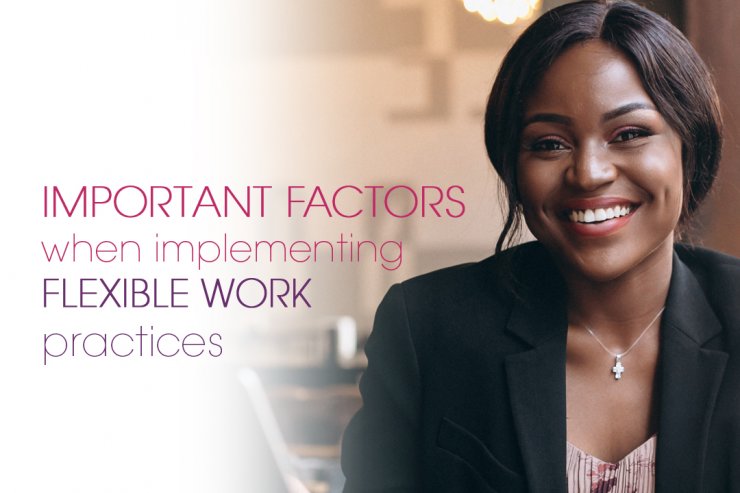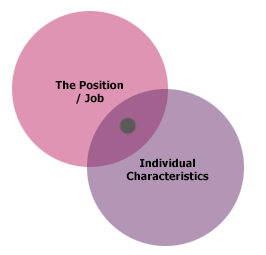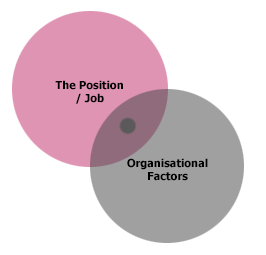
Why trust and competence are not the most important factors when implementing flexible work practices.
In the article Essential Success Elements To Implementing Flexible Work Arrangements In The Work Place we presented the argument that, when one starts taking the first courageous steps to implement flexible work practices, we are likely to do it under the condition of “possible yet less than perfect”.
Feedback from two groups of readers
From the feedback received on this article, it appears that this “less than perfect” condition resonates with many readers. The feedback further confirms our own experience which indicates that the first steps for the majority of corporate clients who attempt to make the change from traditional employment conditions to flexible working conditions, takes place where the individual's characteristics align to the requirements of the job for said flexibility.

The group of readers who says that flexibility can take place when the individual characteristics and job requirements align testified of challenges associated with the next step of making the change at an organisational level. They have consequently requested further guidance on tools and techniques to initiate this change.
A further fascinating situation emerged from a group of small to medium-sized entrepreneurial businesses who are fully remote working organisations. They are finding themselves in the space where the following is apparent:

The jobs align to remote working, and the organisational factors are in place, yet not all the individuals in the organisation are responding positively to remote working (both in productivity and satisfaction). This group, in turn, asked for guidance and tools to support them in better identifying and managing the individual's needs and characteristics with the aim of creating a context where everyone (individual and the organisation) can flourish.
This article aims to provide readers with practical tools and advice which are proven to be effective in bringing about positive and sustainable change.
The aspect most groups are comfortable with is the identification of the type of jobs that lend themselves to flexible working and then matching the job requirements to the type of flexible working options available.
Individual factors impacting flexible work practices
Trust and competence are traditionally and commonly considered as fundamental requirements to guarantee successful implementation of flexible work practices. Although we believe they are important, in our view they are of secondary importance and are easily managed if the matters of individual preference, work style, motivators and value systems are aligned to the job/role and the organisation. These matters have in recent years been recognised for their importance in the traditional 8am-5pm office-based environment and we support that they are also the primary considerations which have the greatest impact on the success of flexible working practices.
Here are two practical examples to substantiate this view
Example 1:
Situation: A new employee is assigned an important project with a client in their region which, according to the background and interview, he/she should be capable of performing. Due to the remote nature of the work, the employee’s superior will not be able to monitor/track his/her progress or intervene and offer support where necessary.
Imagine for a moment that the new employee is not fully competent or confident in performing the task. What are the factors which would be essential to consider that would help both parties to succeed?
The individual/employee: An openness to express his/her lack of confidence and the extent to which he/she is willing to ask for assistance and guidance, his/her preferred style of being managed, his/her inclination towards working independently or collaboratively and perhaps even their motivation, initiative and resilience.
On a collective level: The extent to which there is alignment between the organisation and the individual’s value system is critical. To name but a few: their orientation towards ethics and integrity, orientation towards transparency or privacy, reliance on and respect for rules or preference for independence and innovation.
Example 2:
Situation: A highly capable and skilled individual is moved to work remotely after years of proving himself capable in a traditional office space environment where he flourished and consistently outperformed his peers.
Within the first month of working from home, his performance has deteriorated significantly to now being sub-standard. His personal life has been impacted negatively with his immediate family bearing the brunt of his frustrations. He further testifies of an overall lack of energy and a feeling of disengagement. In discussion with him, it becomes evident that for him, working from home has removed him from a high energy environment which, he now realises was a pivotal contributor to his success.
Consider what information would be useful for managing this situation – either in focusing on a solution or ideally, to have had access to, before making the change to prevent this from having happened.
The individual/employee: Personality, sensory preferences and work styles, motivational drivers, inclination towards independence or collaboration and perhaps even his/her definition of success and the prominence of work in his/her life to name a few.
All of these are critical components which will determine how the situation unfolds and whether the interactions will build or break down the trust relationship as well as the competence and confidence of these individuals.
In both these examples, one where trust and competence are present and the other not, the key to mutual flourishing did not centre on trust or competence, but rather on the individual characteristics as well as the extent to which this aligned with the organisational needs.
Having a reliable, fair and consistent approach to gain insight into the unique makeup of the organisation and the individuals employed has always been important however it becomes even more critical when stepping out into the world of flexible working. What one sees clearly illustrated through these examples is that the individual preferences and characteristics are now critical, and one cannot afford not to understand or consciously navigate them.
Two tools which have proven to be instrumental in gaining such insights both on an individual and an organisation level are
The Sensory matrix focuses on understanding the integration between one's sensory threshold and the work environment. From a sensory perspective, it has amongst other things, provided a clear indication on suitability for home working. It has also proven to be invaluable in facilitating increased self-awareness and an ability to implement effective self-regulation and self-management strategies for those who find themselves in contexts which are not aligned to their sensory preferences.
The Giotto Assessment a work-based integrity assessment measuring the below seven scales which provides one with invaluable information about the individual’s current value system which is likely to motivate or drive their behaviour. The benefits and applicability for the context of flexible working, amongst others, speaks for itself and has proven to be a powerful source of information for both individuals and employers.
In conclusion: When stepping out of all this detail back into why one is doing this, we are reminded that the aim of introducing flexible work practices is to create an environment where both individuals and organisations flourish. To achieve this, we are tasked to create environments where individuals are enabled to perform at their optimum potential for the mutual benefit of themselves and the organisation.
Achieving this, given the complexities and unique needs and preferences of human beings as well as ever-changing organisations, is no easy task.
We trust that after reading this article, one is, however, filled with hope that by focusing on some of the key elements and using the tools at one’s disposal, one can make a positive contribution in navigating this – ultimately taking another step towards making the dream of flexible work a reality.
Author: Rentia Landman – Industrial Psychologist | Professional Coach | HR Consultant | OD Specialist and owner of Landman Consulting



